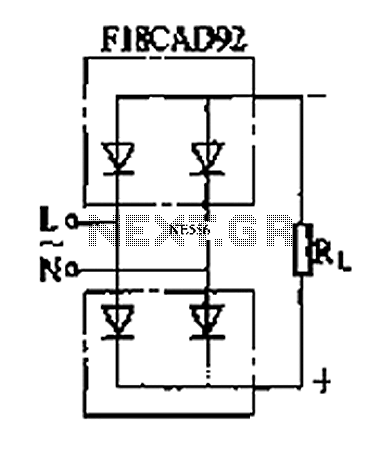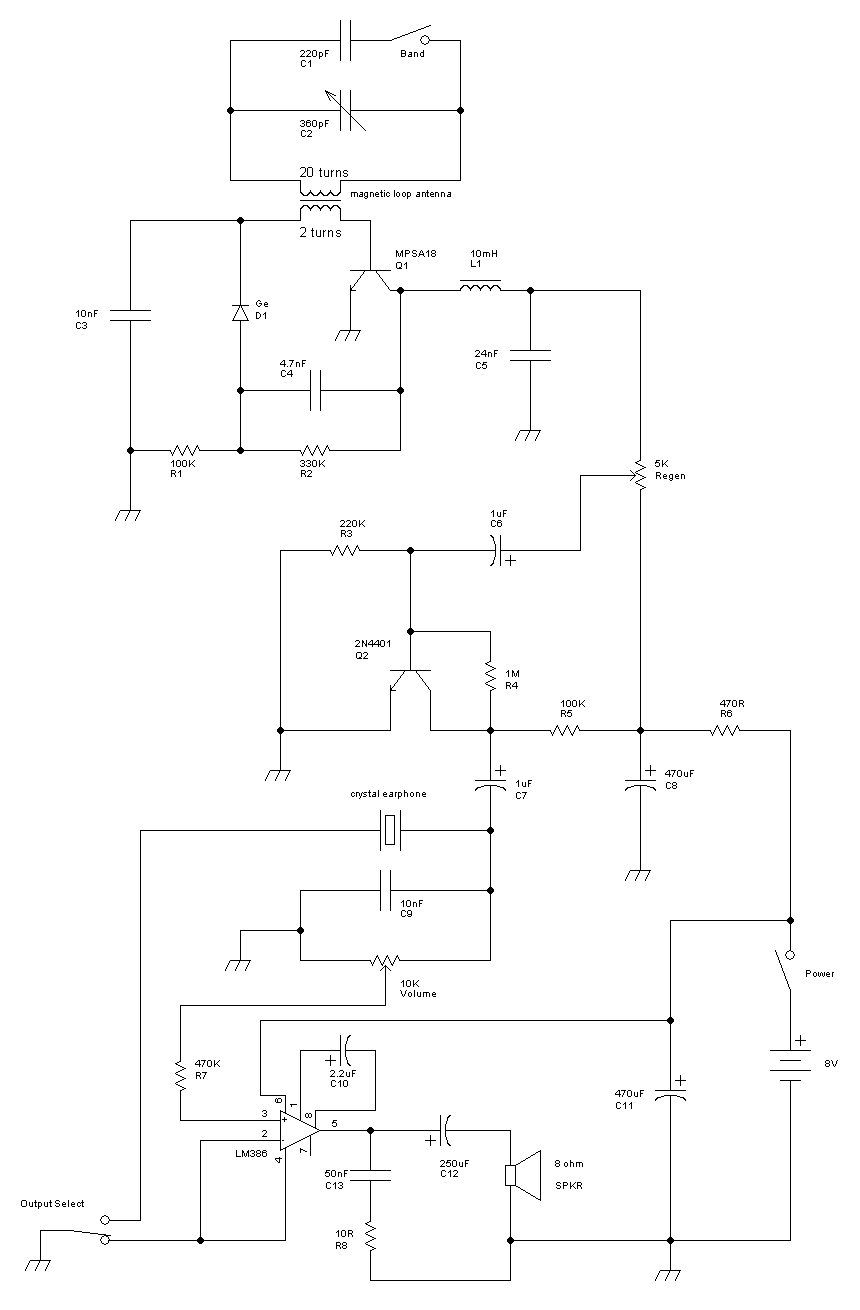
120Ac Shimmering Light Circuit

This circuit allows any standard household bulb to shimmer or blink. It is compatible with incandescent lights up to 200 W and operates on standard 120 Vac. The circuit employs a silicon-controlled rectifier (SCR) to create the shimmering effect. One terminal of the lamp connects directly to the 120 Vac supply, while the other terminal connects to the cathode of the SCR. The incoming AC voltage is full-wave rectified by diodes D1 and D2, converting it to DC. A portion of this DC voltage is applied to capacitor C1 through resistor R2. Diode D3 prevents the positive DC voltage from passing through, allowing only the voltage from the path through resistor R1 and diode D3 to proceed. This configuration forms an oscillator, with its frequency determined by the setting of potentiometer P1, as the other components have fixed values. Caution is advised when using devices connected to the AC line; they should not be used outdoors or near water, and the entire assembly should be housed in an insulated wooden or plastic enclosure to avoid any contact with AC voltage.
This circuit design effectively transforms a conventional incandescent bulb into a dynamic light source capable of shimmering or blinking. The SCR plays a crucial role in modulating the lamp's brightness by controlling the power delivered to it. The full-wave rectification process using diodes D1 and D2 ensures that the AC input is converted to a usable DC output, which is essential for the operation of the capacitor and the subsequent oscillator circuit.
The oscillator's frequency, which is adjustable via potentiometer P1, allows for customization of the shimmering effect. This feature enables users to select a preferred shimmer rate, adding versatility to the lighting effect. The inclusion of capacitor C1 serves to smooth out the voltage fluctuations, providing a stable DC voltage to the SCR and ensuring consistent operation of the circuit.
Safety precautions are paramount when working with circuits connected to the AC mains. It is essential to ensure that all components are rated for the appropriate voltages and currents, and that the assembly is securely housed to prevent accidental contact with live electrical parts. The recommendation to use a wooden or plastic enclosure further enhances safety by providing insulation from electrical shock hazards. Overall, this circuit serves as an innovative solution for creating decorative lighting effects while emphasizing the importance of safety in electrical design. You can turn any ordinary household bulb into one that shimmers or blinks. This circuit works on any incandescent light up to 200 W, arid runs on standard 120 Vac. The circuit uses an SCR to cause an ordinary lamp to sliimmer. Note that one side of the lamp is connected directly to 120 Vac, and the other side of the lamp goes to the cathode of the SCR. As ac voltage is brought into the circuit through the line cord, it is full-wave rectified by diodes D1 and 1)2.
That changes the ac to dc, and a portion of that dc voltage is applied to capacitor CI through R2. Diode D3 blocks the (+) dc voltage so that only the voltage from the path of R1 and D3 is clear. That forms an oscillator, which has a frequency determined by the setting of potentiometer PI (becausc the other components have fixed values). Remember to use extreme caution when using a device that connects to the ac line. Never use it outside or near water and always mount the entire kit inside a wooden or plastic (insulated) box to prevent any contact with the ac voltage.
This circuit design effectively transforms a conventional incandescent bulb into a dynamic light source capable of shimmering or blinking. The SCR plays a crucial role in modulating the lamp's brightness by controlling the power delivered to it. The full-wave rectification process using diodes D1 and D2 ensures that the AC input is converted to a usable DC output, which is essential for the operation of the capacitor and the subsequent oscillator circuit.
The oscillator's frequency, which is adjustable via potentiometer P1, allows for customization of the shimmering effect. This feature enables users to select a preferred shimmer rate, adding versatility to the lighting effect. The inclusion of capacitor C1 serves to smooth out the voltage fluctuations, providing a stable DC voltage to the SCR and ensuring consistent operation of the circuit.
Safety precautions are paramount when working with circuits connected to the AC mains. It is essential to ensure that all components are rated for the appropriate voltages and currents, and that the assembly is securely housed to prevent accidental contact with live electrical parts. The recommendation to use a wooden or plastic enclosure further enhances safety by providing insulation from electrical shock hazards. Overall, this circuit serves as an innovative solution for creating decorative lighting effects while emphasizing the importance of safety in electrical design. You can turn any ordinary household bulb into one that shimmers or blinks. This circuit works on any incandescent light up to 200 W, arid runs on standard 120 Vac. The circuit uses an SCR to cause an ordinary lamp to sliimmer. Note that one side of the lamp is connected directly to 120 Vac, and the other side of the lamp goes to the cathode of the SCR. As ac voltage is brought into the circuit through the line cord, it is full-wave rectified by diodes D1 and 1)2.
That changes the ac to dc, and a portion of that dc voltage is applied to capacitor CI through R2. Diode D3 blocks the (+) dc voltage so that only the voltage from the path of R1 and D3 is clear. That forms an oscillator, which has a frequency determined by the setting of potentiometer PI (becausc the other components have fixed values). Remember to use extreme caution when using a device that connects to the ac line. Never use it outside or near water and always mount the entire kit inside a wooden or plastic (insulated) box to prevent any contact with the ac voltage.





